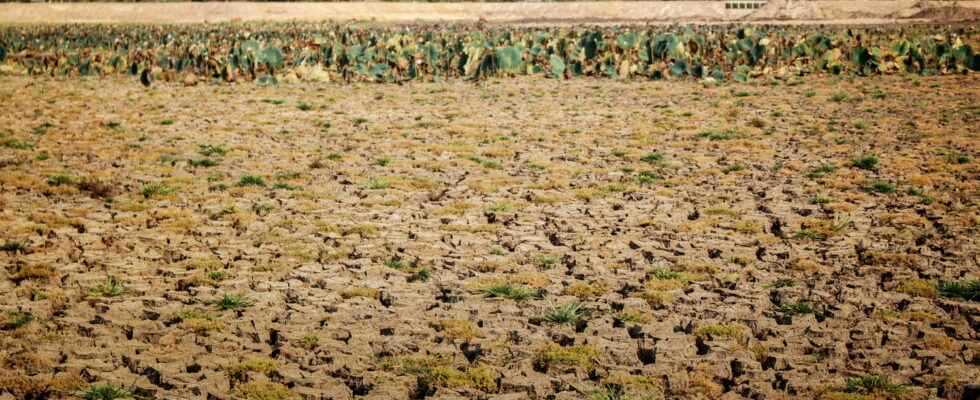DROUGHT. France is on drought alert. To date, 117 municipalities are deprived of drinking water, and 93 departments out of 96 are now on drought alert, beyond vigilance and are affected by water restrictions. We take stock.
[Mis à jour le 23 août 2022 à 10h52] The drought continues in France and the damage is significant. Everyone is affected by water restrictions: individuals, but also farmers who struggle to water their plantations. 117 municipalities are also deprived of water, as recalled on Tuesday on BFMTV Christophe Béchu, Minister for the Ecological Transition: “there are 117 municipalities deprived of drinking water” and “quantities of others for which we have concerns”.
To date, the entire territory is concerned, 3 departments are on drought alert, 13 departments on heightened alert, 77 departments in crisis and only 3 departments are on alert. These are Paris, Seine-Saint-Denis, and Hauts-de-Seine. A few simple actions can be adopted by everyone to limit their consumption. The government gives the right reflexes to adopt:
France is going through a period of #drought intense which now affects the entire territory and which has serious consequences on our ecosystems, but also on human activities.
Preserving our water resources is crucial: let’s all have the right reflexes
– Ministries Ecology Energy Territories (@Ecologie_Gouv) August 5, 2022
July 2022 was the driest month on record since 1958 with a significant rainfall deficit. As a result, many departments are still threatened by drought until the month of autumn. While many water reserves are dry, rationing measures are adopted in several municipalities. Will this be enough to last until the end of the summer?
As of August 24, 2022, 93 departments in mainland France out of 96 are subject to water restrictions to varying degrees and 77, i.e. more than two thirds of the country, are “in crisis”. When this highest level of alert is activated, the watering of lawns, vehicles or the irrigation of crops is prohibited, as is the filling of bodies of water or the cleaning of facades, terraces and courtyards. Only three departments are at the vigilance stage: Paris, Hauts-de-Seine and Seine-Saint-Denis.
The departments at the “crisis” level (red alert): 77 departments are affected by this state of crisis for at least part of their territory. These include Bouches-du-Rhône, Drôme, Indre, Loire-Atlantique, Mayenne and Sarthe, but also parts of the territory such as Alpes-Maritimes, Dordogne, Ille-et-Vilaine, ‘Isère, Loiret, Lot, Puy-de-Dôme, part of Var or Vendée.
What is the drought map of France?
Propluvia is the institute of the Ministry of Ecological Transition responsible for monitoring water levels and the internet platform that allows direct consultation of water restriction orders. The site includes a scalable map to view the areas affected by these prefectural decrees.

The Ministry of Ecological Transition has also published a map summarizing the different alert levels.

Everywhere in France, water restrictions apply, at different levels. Concrete measures have been put in place to limit water consumption for individuals, businesses and communities. For example, it may be forbidden to wash your car or water your garden. In more than a hundred small towns in France, the pipes are empty, underlined the Minister of Ecological Transition Christophe Béchu. This is particularly the case in the Alpes-de-Haute-Provence. Le Fugeret, Le Castellet and Annot are all villages supplied with drinking water by trucks.
There are four main levels of drought vigilance and all of them result in the implementation of specific measures.
- Vigilance drought (level 1): informing and encouraging individuals and professionals to save water.
- Alert (level 2): measures prohibiting the operation of valves, nautical activity, prohibition at certain times of watering gardens, green spaces, golf courses or washing one’s car. For farmers, reduction of levies for agricultural purposes below 50% (or ban up to three days a week).
- Heightened alert (level 3): stronger limitation of withdrawals for watering gardens, green spaces, golf courses, car washing, etc., until certain withdrawals are prohibited. For farmers, reduction of levies for agricultural purposes greater than or equal to 50% (or ban greater than or equal to 3.5 days per week).
- Crisis (level 4): cessation of non-priority withdrawals, including withdrawals for agricultural purposes. Only withdrawals to ensure the exercise of priority uses are authorized. They concern sectors such as health, civil security, drinking water and sanitation.
Individuals have a role to play in limiting drought, in particular through small daily gestures summarized by the website of the Ministry of Ecological Transition:
- Avoid letting the water run
- Limit the watering of my garden,
- Install water-saving equipment,
- Take a shower instead of a bath
- Install a rainwater collector or containers under the gutter downspouts and in the garden to water it,
- Repair water leaks,
- Avoid running your washing machine or dishwasher half empty.
